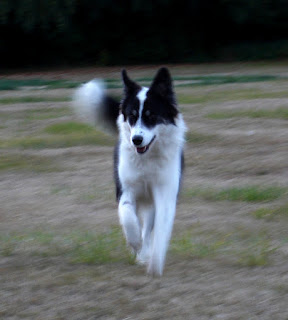Lasers are used to treat pain, stimulate skin healing without scarring, & reduce inflammation. Lasers are so helpful that pet families should be requesting them for their dogs and cats after spay and neuter surgery, with ACL repairs, to treat hip dysplasia, or relieve pain & paralysis of disc disease.
How Do Lasers Work?Lasers use photons, packets of electron energy just as released from the sun. We can’t see these packets of energy, and when a laser is held over a pet’s body, we don’t observe a difference on the outside of the body. The laser’s effect occurs under the skin as photons influence cell membranes and cell mitrochrondira. We choose whether the laser will affect the cells of muscles, tendons, bones, skin or lymph by setting the frequency. On the lasers I use, frequencies run from 73 Hz to 4672 Hz.
• E: 4672 Hz to ease pain, decrease calcium deposition, treat acute fractures, affect C reactive nerve fibers
• D: 2336 Hz to treat flesh wounds, chronic connective tissue problems
• C: 1168 Hz to treat bones, tendons, viscera, relax large muscles, and stimulate periosteum
• B: 584 Hz to increase circulation and resolve edema of lymph tissues, treat neuropathic pain, affect the gut, liver and pancreas
• A: 292 Hz to treat skin and nerves including mucous membranes of the mouth, the cornea of the eye. This setting tones the tissues without increasing blood flow. It helps trigger points, treats infections in wounds and burns. A is the universal setting.
• G: 146 Hz is used to decrease inflammation, reduce fresh scar tissue, treat tendons, stimulate healing of infections • F: 73 Hz is used to stimulate circulation, treat endocrine problems and help healing of acute and chronic conditions
Using Multiple Laser FrequenciesIn general, we use low frequencies to stimulate cellular activity and high frequencies to sedate cells and relieve pain. With the lasers I use, it’s possible to combine frequencies and stimulate healing in multiple tissues. Examples of combination frequencies I use:
• Arthritis: 4672, 1168, 146
• Dermatitis: 292, 146
• Muscle tear: 584, 1168, 146
• Hip dysplasia: 1168, 4673, 146
• Disc disease: 4672, 1168, 584
• ACL damage: 1168, 156
Laser Treatments for Acute Injury With severe, acute injuries, such as disc disease and torn ACL, it’s ideal to treat the injury 3 times a week for a couple weeks, then decrease frequency. Laser treatments are often combined with icing, pain medications that include boswellia and turmeric, moxa, massage and rehab exercises that are done at home. For some pets, homeopathic medications such as Traumeel, arnica, rus tox are prescribed.
Laser Treatments for Chronic Injury With chronic injuries, such as arthritis, it’s ideal to treat dogs & cats once a week for a month. During this time we start an exercise program, start TCM herbal formulas, and consider changes in nutrition that support healing. For example, we increase the pet’s intake of deeply pigmented fruits and veggies to increase their cellular supply of antioxidants and flavonoids. After a month of weekly treatments, many dogs & cats are visibly more comfortable; subsequent visits are scheduled as needed. Usually the chubby pets that have started to lose weight because we’ve got them on an ideal diet will do really well, experiencing a new joy in life.
 Puppies go through 7 learning periods during which they acquire the experience that shapes them for life. The periods phase in and out gradually and are associated with increasing ability to see, hear, think & move. The 7 learning periods start with birth and end when the pup is sexually mature. The periods:
Puppies go through 7 learning periods during which they acquire the experience that shapes them for life. The periods phase in and out gradually and are associated with increasing ability to see, hear, think & move. The 7 learning periods start with birth and end when the pup is sexually mature. The periods:






